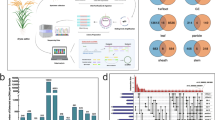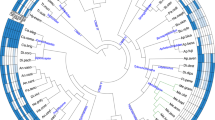Abstract
Microsatellites are a ubiquitous class of simple repetitive DNA sequence. An excess of such repetitive tracts has been described in all eukaryotes analyzed and is thought to result from the mutational effects of replication slippage1. Large-scale genomic and EST sequencing provides the opportunity to evaluate the abundance and relative distribution of microsatellites2 between transcribed and nontranscribed regions and the relationship of these features to haploid genome size. Although this has been studied in microbial and animal genomes3,4,5,6, information in plants is limited. We assessed microsatellite frequency in plant species with a 50-fold range in genome size that is mostly attributable to the recent amplification of repetitive DNA7. Among species, the overall frequency of microsatellites was inversely related to genome size and to the proportion of repetitive DNA but remained constant in the transcribed portion of the genome. This indicates that most microsatellites reside in regions pre-dating the recent genome expansion in many plants. The microsatellite frequency was higher in transcribed regions, especially in the untranslated portions, than in genomic DNA. Contrary to previous reports suggesting a preferential mechanism for the origin of microsatellites from repetitive DNA in both animals8,9 and plants10, our findings show a significant association with the low-copy fraction of plant genomes.
This is a preview of subscription content, access via your institution
Access options
Subscribe to this journal
Receive 12 print issues and online access
$209.00 per year
only $17.42 per issue
Buy this article
- Purchase on Springer Link
- Instant access to full article PDF
Prices may be subject to local taxes which are calculated during checkout


Similar content being viewed by others
Accession codes
Accessions
GenBank/EMBL/DDBJ
References
Tautz, D. & Schlötterer, C. Simple sequences. Curr. Opin. Genet. Dev. 4, 832–837 (1994).
Toth, G., Gaspari, Z. & Jurka, J. Microsatellites in different eukaryotic genomes: survey and analysis. Genome Res. 10, 967–981 (2000).
Gur–Arie, R. et al. Simple sequence repeats in Escherichia coli: abundance, distribution, composition, and polymorphism. Genome Res. 10, 62–71 (2000).
Pupko, T. & Graur, D. Evolution of microsatellites in the yeast Saccharomyces cerevisiae: role of length and number of repeated units. J. Mol. Evol. 48, 313–316 (1999).
Elgar, G. et al. Generation and analysis of 25 Mb of genomic DNA from the pufferfish Fugu rubripes by sequence scanning. Genome Res. 9, 960–971 (1999).
Beckmann, J.S. & Weber, J.L. Survey of human and rat microsatellites. Genomics 12, 627–631 (1992).
San Miguel, P., Gaut, B.S., Tikhonov, A., Nakajima, Y. & Bennetzen, J.L. The paleontology of intergene retrotransposons of maize. Nature Genet. 20, 43–45 (1998).
Arcot, S.S., Wang, Z., Weber, J.L., Deininger, P.L. & Batzer, M.A. Alu repeats: a source for the genesis of primate microsatellites. Genomics 29, 136–144 (1995).
Nadir, E., Margalit, H., Gallily, T. & Ben–Sasson, S.A. Microsatellite spreading in the human genome: evolutionary mechanisms and structural implications. Proc. Natl Acad. Sci. USA 93, 6470–6475 (1996).
Ramsay, L. et al. Intimate association of microsatellite repeats with retrotransposons and other dispersed repetitive elements in barley. Plant J. 17, 415–425 (1999).
Morgante, M. & Olivieri, A.M. PCR–amplified microsatellites as markers in plant genetics. Plant J. 3, 175–182 (1993).
Lagercrantz, U., Ellegren, H. & Andersson, L. The abundance of various polymorphic microsatellite motifs differs between plants and vertebrates. Nucleic Acids Res. 21, 1111–1115 (1993).
Metzgar, D., Bytof, J. & Wills, C. Selection against frameshift mutations limits microsatellite expansion in coding DNA. Genome Res. 10, 72–80 (2000).
Shama, S. & Meyuhas, O. The translational cis–regulatory element of mammalian ribosomal protein mRNAs is recognized by the plant translational apparatus. Eur. J. Biochem. 236, 383–388 (1996).
Martienssen, R.A. & Colot, V. DNA methylation and epigenetic inheritance in plants and filamentous fungi. Science 293, 1070–1074 (2001).
Cardle, L. et al. Computational and experimental characterization of physically clustered simple sequence repeats in plants. Genetics 156, 847–854 (2000).
Crollius, H.R. et al. Characterization and repeat analysis of the compact genome of the freshwater pufferfish Tetraodon nigroviridis. Genome Res. 10, 939–949 (2000).
Hartl, D.I. Molecular melodies in high and low C. Nature Rev. Genet. 1, 145–149 (2000).
Meyers, B.C., Tingey, S.V. & Morgante, M. Abundance, distribution and transcriptional activity of repetitive elements in the maize genome. Genome Res. 11, 1660–1676 (2001).
The Arabidopsis Genome Initiative. Analysis of the genome sequence of the flowering plant Arabidopsis thaliana. Nature 408, 796–815 (2000).
Hancock, J.M. Simple sequences and the expanding genome. BioEssays 18, 421–425 (1996).
Schlötterer, C. & Harr, B. Drosophila virilis has long and highly polymorphic microsatellites. Mol. Biol. Evol. 17, 1641–1646 (2000).
International Human Genome Sequencing Consortium. Initial sequencing and analysis of the human genome. Nature 409, 860–921 (2001).
Bennetzen, J.L. Comparative sequence analysis of plant nuclear genomes: microcolinearity and its many exceptions. Plant Cell 12, 1021–1030 (2000).
Kumar, A. & Bennetzen, J.L. Plant retrotransposons. Annu. Rev. Genet. 33, 479–532 (1999).
Rabinowicz, P.D. et al. Differential methylation of genes and retrotransposons facilitates shotgun sequencing of the maize genome. Nature Genet. 23, 305–308 (1999).
Keller, B. & Feuillet, C. Colinearity and gene density in grass genomes. Trends Plant Sci. 5, 246–251 (2000).
Copenhaver, G.P. et al. Genetic definition and sequence analysis of Arabidopsis centromeres. Science 286, 2468–2474 (1999).
Schlötterer, C. Evolutionary dynamics of microsatellite DNA. Chromosoma 109, 365–371 (2000).
Stuart–Rogers, C. & Flavell, A.J. The evolution of Ty1–copia group retrotransposons in Gymnosperms. Mol. Biol. Evol. 18, 155–163 (2001).
Pfeiffer, A., Olivieri, A.M. & Morgante, M. Identification and characterization of microsatellites in Norway spruce (Picea abies K.). Genome 40, 411–419 (1997).
Meyerowitz, E.M. in Methods in Arabidopsis Research (eds. Koncz, C., Chua, N.–H. & Schell, J.) 100–118 (World Scientific Publishing, Singapore, 1992).
Dhar, M.S., Dabak, M., Gupta, V.S. & Ranjekar, P.K. Organization and properties of repeated DNA sequences in rice genome. Plant Science 55, 43–52 (1988).
Goldberg, R.B. DNA sequence organization in the soybean plant. Biochem. Genet. 16, 45–68 (1978).
Hake, S. & Walbot, V. The genome of Zea mays, its organization and homology in related grasses. Chromosoma 79, 251–270 (1980).
Smith, D.B., Rimpau, J. & Flavell, R.B. Interspersion of different repeated sequences in the wheat genome revealed by interspecies DNA/DNA hybridisation. Nucleic Acids Res. 3, 2811–2825 (1976).
Acknowledgements
We thank B. Li, K. Henderson for the soybean and wheat libraries, M. Dolan and the DuPont Genomics group for technical help and J.A. Rafalski and B. Mazur for discussions and comments on the manuscript.
Author information
Authors and Affiliations
Corresponding author
Rights and permissions
About this article
Cite this article
Morgante, M., Hanafey, M. & Powell, W. Microsatellites are preferentially associated with nonrepetitive DNA in plant genomes. Nat Genet 30, 194–200 (2002). https://doi.org/10.1038/ng822
Received:
Accepted:
Published:
Issue Date:
DOI: https://doi.org/10.1038/ng822
This article is cited by
-
Optimized protocol for high-frequency papaya propagation: morpho-stereomicroscopic analysis and genetic fidelity assessment
Plant Cell, Tissue and Organ Culture (PCTOC) (2024)
-
Comparative genomics reveals insights into anuran genome size evolution
BMC Genomics (2023)
-
Linkage mapping and identification of quantitative trait loci associated with bacterial leaf blight resistance and gum content in cluster bean using the interspecific population (HG563 × Cyamopsis serrata)
Genetic Resources and Crop Evolution (2023)
-
SSR mining of black cumin (Nigella sativa L.) transcriptome for molecular marker development
Genetic Resources and Crop Evolution (2023)
-
DNA fingerprinting and genetic diversity analysis in Asparagus officinalis L. cultivars using microsatellite molecular markers
Genetic Resources and Crop Evolution (2023)



